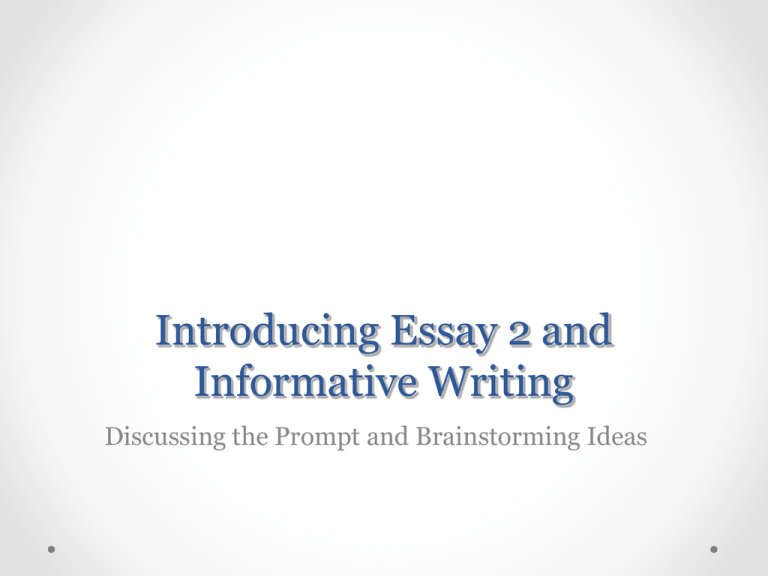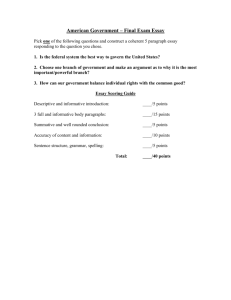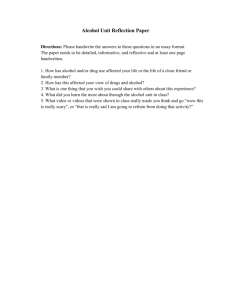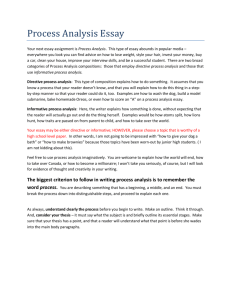Introducing Essay 1 and Discussing Informative Writing
advertisement

Introducing Essay 2 and Informative Writing Discussing the Prompt and Brainstorming Ideas Congrats on Finishing Your Midterm! Freewrite: • Think of a topic—any topic—that you don’t know a lot about but are interested in. You may not know much about it, but you want to find out more. o For example, I don’t know much about cars and automobile maintenance, but I would like to learn at least the basics. • Then, think of a topic that you do know a lot about, that you think is interesting and that other people might find interesting too. Write a little about it. o For example, I know a lot about fantasy novels. • Did you know that parts of The Lord of the Rings were influenced by JRR Tolkien’s experiences in WW1? Also, the Twilight novels were definitely not the first books about a vampire/human romance? In fact these stories are extremely old—the first was probably Carmilla, published in 1872 and predating Dracula by 26 years! The Informative Essay Why Write an Informative Essay? • Informative writing is practical. o It is the kind of writing you are most likely to write in the workplace o It shares information on specialized topics • Informative writing can help highlight important issues and causes, or subjects and subcultures that are not well-known. • Informative writing can help dispel misconceptions, and fight against stereotypes and prejudice. o Don’t forget: education is the enemy of hate and fear. Keys to Informative Writing, continued • EXPLAIN INFORMATION FOR YOUR READER o Just because you have become familiar with the topic does not mean that your reader is. o Give background and history that your reader will need in one or two paragraphs early on. o Part of your job is to break it down and explain things in a logical, step-by-step manner. o Make it interesting and easy to understand! • EXPLORE QUESTIONS AND PROBLEMS o Find out what the current debates are relating to your topic. o What is commonly known? What is not known? o Readers like to read about controversy. If there is a controversy relating to your topic, discuss it! o What fascinates you about this topic? Get your reader to SHARE your fascination by explaining and exploring what you find so fascinating. Discuss the Prompt • Pass out Prompt and Discuss • Take notes on the prompt. • Write ideas and questions on it! Steps in Creating an Informative Essay • Most of the work on an informative essay is done before you actually sit down to type. Here are the general steps to take: 1. After you have chosen the topic, you will need to gather all the pertinent details on that subject. You need to ascertain what you already know about the subject and then decide what you need to research to make your essay well-informed and complete. 2. You will need to make a list of the important facts and then list the main steps in your paper. Make sure all your facts are accurate. You will need to write a topic sentence for each fact and write a focus sentence (thesis statement) for the entire essay. Steps in Creating an Informative Essay • Most of the work on an informative essay is done before you actually sit down to type. Here are the general steps to take: 3. Create an outline that will organize your facts in a logical way. Then you will be ready to make your first draft. 4. Editing is an important step for any writing project. Reading your essay out loud will help you notice places where the writing is awkward or unclear. If possible, have someone else read it and give you their ideas for improvement. Of course, you will need to pay attention for grammar, punctuation, spelling, capitalization, and other errors. Subject Options for Informative Essays • Informative essays, sometimes called expository essays, can be used for many purposes. They can compare viewpoints on a controversial subject as long as they don’t include the author’s opinions. They may analyze data, like in a cause and effect situation, or educate the audience on ways to do something, like solving a certain kind of problem. o An informative essay might educate the audience on how to open a bank account. • Or how to buy a house • Or understand your credit score o An informative essay might explain the health benefits of a Vegetarian or Vegan Diet. • Or the importance of exercise o An informative essay might discuss the cost savings of Hybrid vehicles • Or why having your air ducts cleaned is important • Or what “green washing” is and how to identify real eco-friendly products Changes to the Schedule Next Week: Week 13 – Tuesday, November 24 • The new stuff is in BOLD and UNDERLINED • Due Next Week: • Read in Pathways o “Essay Basics and Development” pg. 476—481 o “Process Paragraphs” pg. 397-400 o Example Paragraphs” pg.380-382 • Also Read o “Ways to Improve Your Memory” pg. 36 o “The Playlist’s the Thing” pg. 169 Break Time! Please return in 10 to 15 minutes The Structure and Organization of an Informative Essay • The basic structure of an informative essay is very simple. It needs to have a beginning, middle, and end. • The beginning needs to present the topic and grab the attention of the audience. It needs to include the focus sentence for the entire essay. • The middle will be the main bulk of the essay and it will contain all the important facts that you are covering. This is where the audience will get their questions answered. Remember to answer these questions: who, what, where, when, why, and how. • The end is a conclusion where you will summarize the essay. It should spur the reader or listener to learn more about the topic. The Introduction • Here is an example of the beginning of an informative essay: o “You might not think that today is the day that you will save a life, but it might be. It is quite easy to save a life any day and it only takes a little bit of your time. I’m not talking about being a paramedic or fireman; I am talking about donating blood.” The Conclusion • Here is an example of a conclusion for an informative essay: o “So that now you know how easy it is to donate blood, it’s time to take action. After all, you have plenty of blood, so why not share? When you do, you will feel good about yourself and you will save a life.” But What About All the Stuff in the Middle? The Body Paragraphs What is a paragraph? • A paragraph is a group of sentences that work together for a common purpose. • All of the sentences in a paragraph are about the same general topic. • Each sentence works with the others in order to achieve the purpose of the paragraph. • Paragraphs contain a topic sentence and two different types of support: primary support and secondary support. • Each new paragraph is indented five spaces. What is a topic sentence? • Your topic sentence introduces the main idea of your paragraph. • A topic sentence has two parts: a topic an a controlling idea. o Your topic is what the paragraph is about. o Your controlling idea is the opinion or idea about the topic that the paragraph will explain. Example Topic Sentences • Let’s say that you were writing a paragraph about the topic “Cell phones.” • There are many different ideas or opinions about cell phones that you could explore, so it’s important to pick just one. You might write… – Cell phones that can connect to the internet have changed the way people shop. – Cell phones and texting should be banned during class time. Supporting Your Topic Sentence • When you have decided what your topic and your controlling idea will be, it is time to support your topic sentence. o Primary support points are the major ideas that support your topic sentence. (They are usually general rather than specific.) o Secondary support points are specific examples and details that back up your primary support. Example Paragraph Outline • • • • Topic Sentence: Cell phones that can connect to the internet have changed the way people shop. Primary support 1: Able to check reviews online. • Secondary support: Checked reviews for digital camera at Best Buy. • Secondary support: Check reviews of new authors at amazon.com before buying at a local bookstore. Primary support 2: Able to compare prices at other stores while shopping. • Compared prices for The Man from UNCLE movie on the first day it was out. • Compared prices for new flash drive when I lost my old one. Primary support 3: Able to use coupons without ever printing them out. • Used a 40% off coupon scanned off of my iPhone at World Market last week. • Used Target’s “Cartwheel” app to save on groceries and medical supplies. Completed Paragraph Cell phones that can connect to the internet have changed the way people shop. First of all, customers can immediately check reviews online before making a decision. When I was shopping for a digital camera at Best Buy, I used an iPhone to see which brand had the most positive reviews. Also, when I buy a book by a new author at a local bookstore, I sometimes check reviews of his or her books at amazon.com first. Second, customers can compare prices at other stores while they are out shopping. When the movie The Man from U.N.C.L.E. came out, I compared prices online and was surprised to find that Target had a better price than some online discount stores. I also compared prices using a cell phone when I lost my flash drive and had to buy a new one. Finally, customers are able to use in-store coupons without ever printing them out, which saves a lot of money, paper, and ink. Last week, I used a 40% off coupon scanned off of my phone at World Market, and I just started using Target’s “Cartwheel” app to save on groceries and other basics. In these ways, cell phones are making it easier for customers to find the best deals and make informed decisions. Discussing This Week’s Reading as an Example of Informative Writing “Credit Card Smarts: Take Charge of Your Card” on page 146 Group Discussion: • Get in groups of 3 or 4. • After you are in your groups, take a few minutes to review the reading silently on your own and refresh your memory on the main points in this reading. • After you all do this, discuss the reading and connect it to your own experiences: o Which do you currently use to pay for purchases most often: cash, check, credit card or debit card? o Have you ever used a credit card to buy something “big”? o Have you ever used a credit card for daily expenses you could not afford? o Did you learn anything new by reading this essay, or was it mostly information you have already heard elsewhere? Check Out the Idea Map on pg.149 • On page 149, there is an idea map that lays out the organization on the essay “Credit Card Smarts”. • There are gaps in the idea map. • As a team, your group should fill in the missing sections. • There are 8 missing sections. Number them on a piece of paper and fill in what’s missing. • Be sure to put everyone’s name on it for in-class credit. Finding Topics • What are some “interesting questions” you could ask that might lead to a paper topic? • Sometimes, the best way to jump start your own ideas is to look for examples of the kind of writing you want to do. o Find examples of informative writing in magazines and newspaper. Feature articles are often informative but not “straight news” (i.e. reporting an event rather than exploring an idea.) We want to focus on exploring ideas. Find Examples of Informative Writing • Feature Articles in Magazines and Newspapers often work well for this: o http://ngm.nationalgeographic.com/featurehub o http://www.scientificamerican.com/department.cfm?id=feature-article • Let’s look at them. • Remember, these are only two examples. • There are thousands out there! o Extra Credit Challenge: Find an informative essay (a short one please!) and bring a printed copy to class next week! Brainstorm Your Topic Ideas! • Look at the prompt for the Informative Essay again. • On the back, (or in your notebook if you prefer) start brainstorming your topic ideas. • Please feel free to come ask me if you have any questions about the prompt OR the changes to the schedule and homework. Next Week Reminders: • Week 13 – Tuesday, November 24 o In Class: Discuss writing informatively and with examples. Also creating a strong thesis statement. • Due: o Read Pathways • “Essay Basics and Development” pg. 476—481 • “Process Paragraphs” pg. 397-400 • Example Paragraphs” pg.380-382 o Also Read • “Ways to Improve Your Memory” pg. 36 • “The Playlist’s the Thing” pg. 169






